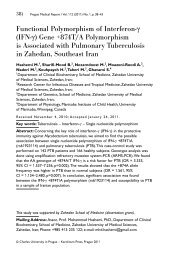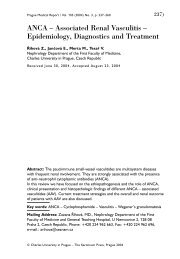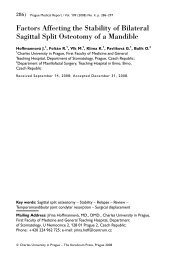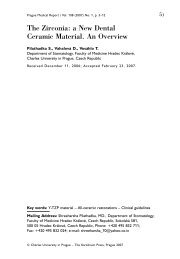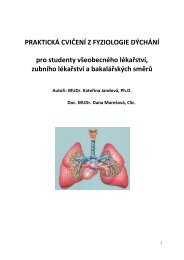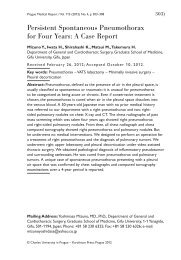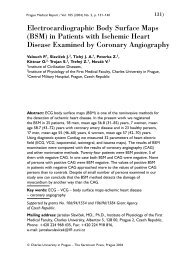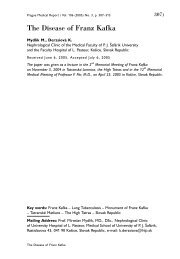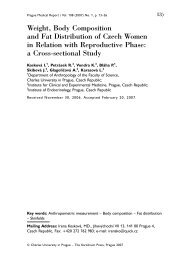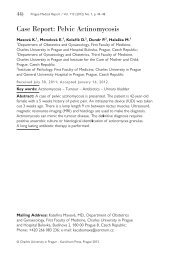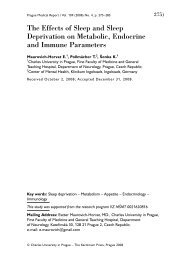(PDF). - Prague Medical Report
(PDF). - Prague Medical Report
(PDF). - Prague Medical Report
Create successful ePaper yourself
Turn your PDF publications into a flip-book with our unique Google optimized e-Paper software.
<strong>Prague</strong> <strong>Medical</strong> <strong>Report</strong> / Vol. 113 (2012) No. 2, p. 136–146<br />
137)<br />
age related controls (lower limit 218–450 nmol/l). Neurological findings including<br />
severe psychomotor retardation, quadruspasticity and microcephaly accompanied<br />
with marked dystonia, excessive sweating in the first patient was compatible with<br />
the diagnosis of tyrosine hydroxylase (TH) deficiency (type B) and subsequent<br />
molecular analysis revealed two novel heterozygous mutations c.636A>C and<br />
c.1124G>C in the TH gene. The treatment with L-DOPA/carbidopa resulted in the<br />
improvement of dystonia. Magnetic resonance imaging studies in two other patients<br />
with microcephaly revealed postischaemic brain damage, therefore secondary<br />
HVA deficit was considered in these children. Diagnostic work-up in patients with<br />
neurometabolic disorders should include analysis of neurotransmitter metabolites in<br />
CSF.<br />
Introduction<br />
Paediatric neurotransmitter disorders refer to an inherited group of neurometabolic<br />
syndromes attributable to a disturbance of neurotransmitter metabolism. Ten<br />
enzyme deficiencies in the pathway of the biogenic amines metabolism have been<br />
described, until now (Pearl et al., 2007). The enzyme tyrosine hydroxylase (TH;<br />
EC 1.14.162) catalyzes the conversion of L-tyrosine to L-dihydroxyphenylalanine<br />
(L-dopa), which is the rate-limiting step in the biosynthesis of the catecholamines<br />
dopamine, norepinephrine and epinephrine.<br />
Human tyrosine hydroxylase deficiency (THD; OMIM 191290) is an autosomal<br />
recessive neurometabolic disorder due to mutations in the TH gene on<br />
chromosome 11p15.5 (Lüdecke et al., 1996). Many different features of THD<br />
(hypokinesia, bradykinesia, rigidity, dystonia, chorea, tremor, oculogyric crises,<br />
ptosis and hypersalivation, among others) are caused by cerebral dopamine and<br />
norepinephrine deficiency (Grattan-Smith et al., 2002). After careful evaluation of<br />
the detailed case histories in the literature, it was possible to class the different<br />
phenotypes at presentation into two major groups: an infantile progressive<br />
hypokinetic-rigid syndrome with dystonia (type A) and a neonatal complex<br />
encephalopathy (type B). In almost all patients with type A THD, treatment with<br />
L-dopa results in an excellent response, sometimes even a miraculous improvement<br />
of the neurological condition. In type B, L-dopa treatment does not improve all<br />
signs equally, and it may take months before all effects of treatment become clear<br />
(Willemsen et al., 2010).<br />
Tyrosine hydroxylase deficiency can be diagnosed by demonstrating decreased<br />
CSF levels of the metabolites of the catecholamine degradation pathway (Figure 1),<br />
homovanillic acid (HVA) and 3-methoxy-4-hydroxyphenylethylene glycol (MHPG)<br />
and by mutation analysis of the TH gene. Since dopamine suppresses the release<br />
of prolactin, THD may lead to hyperprolactinaemia (Hyland, 1999). Disease in<br />
affected infants may remain undiagnosed because extrapyramidal or parkinsonian<br />
symptoms do not predominate in that age group. Likely misdiagnoses are suspicion<br />
of unexplained neonatal death, neuromuscular disorders, or cerebral palsy (CP)<br />
Czech Patient with Tyrosine Hydroxylase Deficiency



